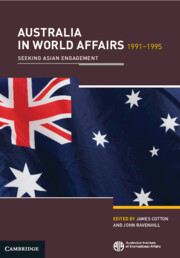Book contents
- Frontmatter
- Contents
- Tables
- Abbreviations
- Contributors
- Preface
- 1 Australia’s ‘Engagement with Asia’
- 2 An Overview
- 3 The Rhetoric of Asia
- 4 Australia and Asia: A View From Europe
- 5 Australia’s Defence Policies in the Post–Cold War Era
- 6 Australia, Disarmament and Arms Control
- 7 Australia and the World Economy 1991–95: Closer Economic Integration with Asia?
- 8 Australia and the International Environment
- 9 Australia and Japan
- 10 Australia and Southeast Asia
- 11 Australia and China, 1991–95: Asymmetry and Congruence in the Post–Cold War Era
- 12 Australia and the Four Asian Dragons: Beyond the Economic Agenda?
- 13 Reassessed: Australia’s Relationship with the United States
- 14 Australia and the European Union
- 15 Australian Relations with the Former Communist States of Europe and the Soviet Union
- 16 Australia and New Zealand: Unequal Partners on the Periphery
- 17 Australia and the South Pacific: The Rationalist Ascendancy
- Notes
- Index
8 - Australia and the International Environment
Published online by Cambridge University Press: 04 May 2024
- Frontmatter
- Contents
- Tables
- Abbreviations
- Contributors
- Preface
- 1 Australia’s ‘Engagement with Asia’
- 2 An Overview
- 3 The Rhetoric of Asia
- 4 Australia and Asia: A View From Europe
- 5 Australia’s Defence Policies in the Post–Cold War Era
- 6 Australia, Disarmament and Arms Control
- 7 Australia and the World Economy 1991–95: Closer Economic Integration with Asia?
- 8 Australia and the International Environment
- 9 Australia and Japan
- 10 Australia and Southeast Asia
- 11 Australia and China, 1991–95: Asymmetry and Congruence in the Post–Cold War Era
- 12 Australia and the Four Asian Dragons: Beyond the Economic Agenda?
- 13 Reassessed: Australia’s Relationship with the United States
- 14 Australia and the European Union
- 15 Australian Relations with the Former Communist States of Europe and the Soviet Union
- 16 Australia and New Zealand: Unequal Partners on the Periphery
- 17 Australia and the South Pacific: The Rationalist Ascendancy
- Notes
- Index
Summary
In areas of environmental interest to Australia, the period between 1990 and 1995 was an active one internationally. It saw Antarctica formally protected from mining or oil drilling; enhancement of global cooperation to protect the ozone layer; a substantial rise in international, including regional, interest in global climate change; and, despite (perhaps, given the adverse international reaction, because of) the renewal of nuclear testing, particularly by France in the Pacific, the development of a comprehensive nuclear test ban treaty, on which Australia has put great emphasis. The five years also encompassed a second global environment conference, the UN Conference on the Environment and Development (UNCED), held in Rio de Janeiro in 1992 (the first, the UN Conference on the Human Environment, was held in Stockholm in 1972). The 1992 Rio conference can be seen in one sense as having been a valuable means of creating a greater awareness of the issues and increasing substantially the international machinery for dealing with co-operation in the environment field as well as spawning a variety of international conventions to which Australia adhered.
Keywords
- Type
- Chapter
- Information
- Australia in World Affairs 1991–1995Seeking Asian Engagement, pp. 82 - 96Publisher: Cambridge University PressFirst published in: 2024



